9+ SAMPLE Crisis Management Communication Plan
-
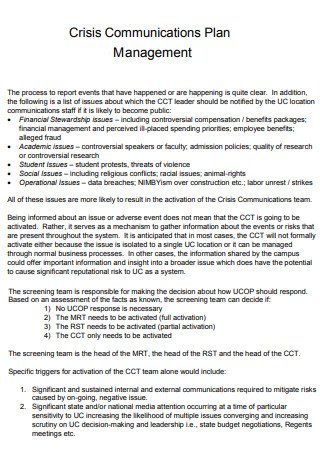
Crisis Management Communication Plan
download now -

Crisis Incident Management Communication Plan
download now -
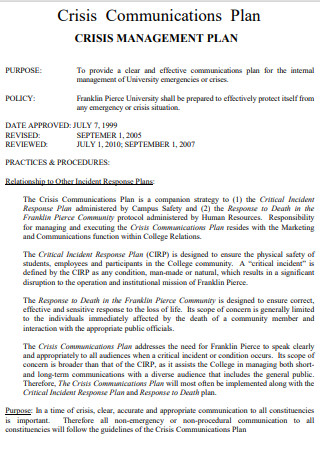
Sample Crisis Management Communication Plan
download now -
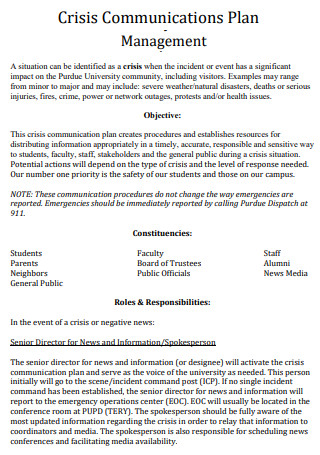
University Crisis Management Communication Plan
download now -
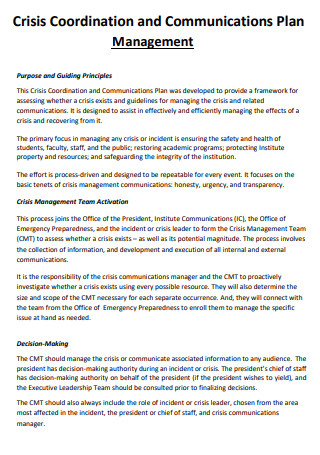
Crisis Management Coordination Communication Plan
download now -
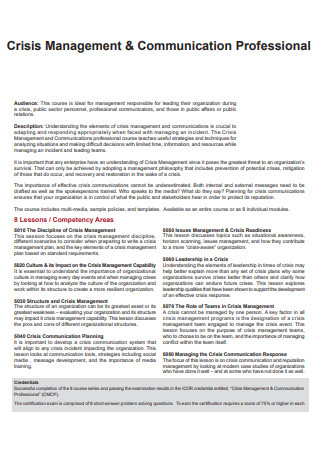
Crisis Management Communication Professional Plan
download now -
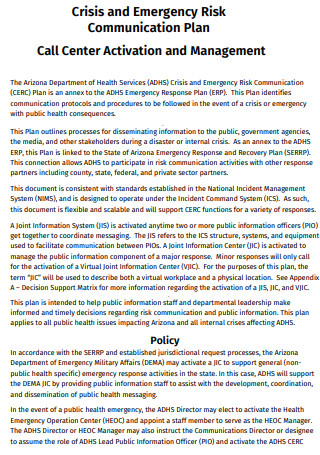
Crisis Risk Management Communication Plan
download now -
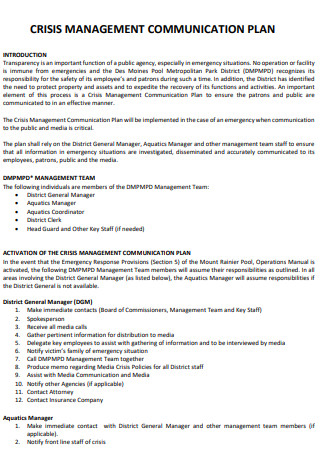
Standard Crisis Management Communication Plan
download now -
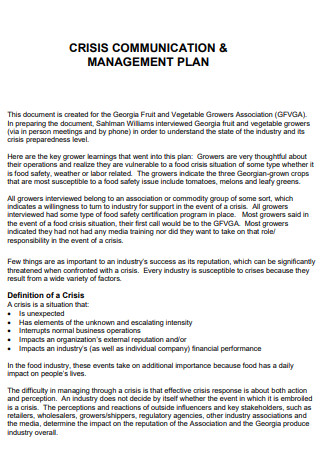
Basic Crisis Management Communication Plan
download now -
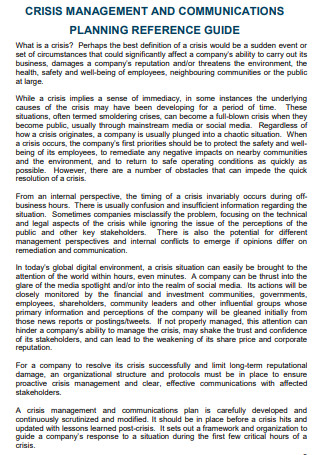
Printable Crisis Management Communication Plan
download now
Crisis Management Communication Plan
9+ SAMPLE Crisis Management Communication Plan
What is a Crisis Management Communication Plan?
Parts of a Crisis Management Communication Plan
Different Types of Crises
Steps in Crisis Management
FAQs
What part does social media play in a crisis situation?
What is the difference between crisis management and risk management?
How important is customer feedback for a crisis situation?
What is a Crisis Management Communication Plan?
First of all, what defines crisis management? Crisis management is referred to as the ways in which a certain company determines a threat that may hamper their operations within or their relationship with their stakeholders and investors in order to find ways in which they can mount an effective response to said crises. Different companies can face different types of crises, such as natural disasters, security breaches, or even problems relating to their personnel.
What is a crisis management communication plan? It refers to a business document that outlines a set of steps to prepare a company for an unexpected scenario that may affect its operations on a small or large scale. This document mainly focuses on the company’s response to a crisis and the methods on which it will manage such a crisis and communicate it to its stakeholders. Having this document in hand is an advantage since it guarantees the efficient and secure release of information, and it also helps messaging to be consistent across all platforms of communication.
Parts of a Crisis Management Communication Plan
When drafting a crisis management communication plan, it is important that it should be easily adaptable since you never really know what type of crisis can unfold in your workplace. And when drafting a crisis management communication plan, here are the important elements that you should include:
Different Types of Crises
Listed and discussed below are some of the different types of crises that you can face in your work environment:
Steps in Crisis Management
Every company, no matter how small or big they may be, will always be vulnerable to crises. And effective management of a crisis situation will greatly reduce the impact it can have on the company. With that being said, listed and discussed below are the steps needed to effectively manage a crisis situation.
-
1. Anticipation
This is the first step in managing a crisis situation. What it means is that everyone in the company should be adequately prepared and organized. One thing you can do is to arrange an extensive brainstorming session to look over all of the potential disasters that might occur in your organization. Not only may certain scenarios be avoided by simply changing systems, but an efficient evaluation process should also result in the development of a proper crisis response strategy.
-
2. Create and Test a Plan
Creating and testing a plan according to what you’ve prepared for would be the next step in managing a crisis. In formulating a plan, keep in mind that it should be customized for your organization and contain both operational and communication components. Also, it is necessary to test the plan that was devised in order to guarantee that the messages included within it are conveyed successfully and with credibility. Most importantly, adopting these steps will guarantee that you can implement your response plan in practice, not just in theory.
-
3. Identify and Build Your Team
Once an appropriate response plan has been created and tested, now is the time to identify who comprises your communication team. In this step, keep in mind that your organization’s crisis communications team should be comprised of a small group of senior executives. Preferably, the CEO of the company will lead the team, with the firm’s top public relations officer and legal counsel serving as primary advisers; the size of the team will then be determined by the demands of your organization. This group should establish your company’s communication strategy. Most crucially in this step, ensure that a clear procedure is developed and communicated to your team.
-
4. Creation of Notification and Monitoring Systems
After building your team, this is the next step that should be done when managing a crisis. In this step, monitoring stakeholder input during a crisis helps you to precisely change your strategy and methods. Furthermore, your organization should have the ability to communicate with internal and external stakeholders as early as practical.
-
5. Emphasis on Communication
This step is probably the most crucial one when it comes to managing a crisis situation. Why? because communication is the fundamental rule of crisis management. Be as transparent as possible. This means to state what you understand and when you become aware of it; clarify who is connected and what steps are being taken to rectify the issue. It is also crucial that when misinformation appears, make certain to correct it as soon as possible.
-
6. Analysis
This serves as the final step of managing a crisis situation. Following a crisis, a formal study of what went well, what may be done better next time, and how to enhance various components of your plan will be conducted. This is also another essential task for any crisis communications team. As the crisis is beginning to be brought under control, the company should conduct an assessment concerning how effective its crisis plan was and the effects the incident had on its employees, brands, and reputation.
FAQs
What part does social media play in a crisis situation?
In today’s time, social media plays a part in almost everything. This includes getting involved in crisis situations, too. For example, a viral film that portrays your company negatively can lead to loads of people forming an unfavorable view of your brand. Luckily, situations like this can be ironed out online. To do this, more people can be deployed to monitor your social channels or update followers with fresh information to lessen the negative consequences of a crisis online. This is especially crucial since all types of information, including incorrect information, may quickly leak into the internet when it comes into the wrong hands.
What is the difference between crisis management and risk management?
Crisis management vastly differs from risk management. This is because risk management refers to preparing for future adverse occurrences that can occur, whereas crisis management entails responding to unfavorable events both during and after they occur.
How important is customer feedback for a crisis situation?
Collecting customer feedback is especially important since it can play a role in preventing a crisis from unfolding. This is due to the fact that customer feedback, as the name suggests, gives information into how customers perceive your company. This helps you to identify key impediments before they become a problem. It also allows consumers to give negative feedback, which you may utilize to enhance the experiences of other customers.
Creating an effective crisis management communication plan is essential since it enables effective decision making which in turn will alleviate the adverse effects of a crisis situation. Also, taking swift action may be the key to the future of the company if it ever undergoes a crisis. Should you need help in making one, this article contains examples of a crisis management communication plan that you can download and use as a guide.
